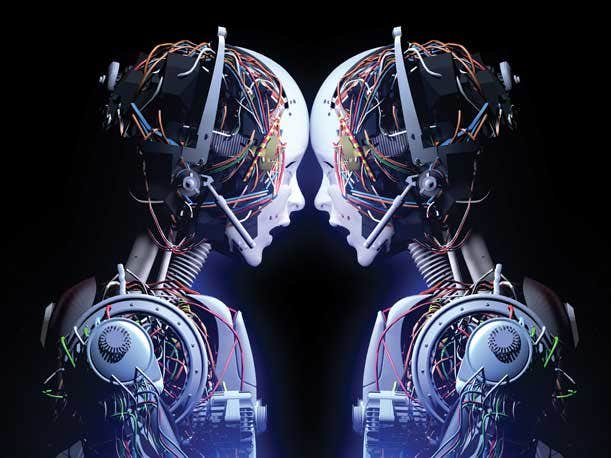Gartner’s 10 Biggest Tech Trends For 2024: AI, GenAI And Machine Customers
Here are Gartner’s 10 boldest IT predictions for 2024, including GenAI, augmented-connected workforce and growth in machine customers.

Gartner has some very bold predictions for the tech world in 2024—from democratized generative AI and artificial intelligence security management to growth in “machine customers” and an augmented-connected workforce.
“Technology disruptions and socioeconomic uncertainties require willingness to act boldly and strategically enhance resilience over ad hoc responses,” said Bart Willemsen, vice president and analyst at Gartner in a new report. “IT leaders are in a unique position to strategically lay down a roadmap where technology investments help their business’s sustenance of success amidst these uncertainties and pressures.”
The IT research firm has identified 10 strategic IT trends in store for 2024, a year that’s predicted to feature more tech-related spending.
Worldwide IT Spending To Hit $5.14 Trillion
Gartner is predicting worldwide IT spending to reach $5.14 trillion in 2024, up from $4.72 trillion this year. This would represent an annual growth rate of nearly 4 percent year over year.
The largest sales-generating tech markets in 2024 will be around IT services, software and communications services.
Gartner’s Chris Howard said executives must evaluate the impacts and benefits of strategic technology trends next year.
“Generative and other types of AI offer new opportunities and drive several trends. But deriving business value from the durable use of AI requires a disciplined approach to widespread adoption along with attention to the risks,” said Howard, distinguished vice president analyst and chief of research at Gartner in a statement.
Generative AI
Gartner says generative AI (GenAI) is becoming democratized by the convergence of massively pretrained models, cloud computing and open source, making these models accessible to workers worldwide.
By 2026, Gartner predicts that over 80 percent of enterprises will have used GenAI APIs and models and/or deployed GenAI-enabled applications in production environments, up from less than 5 percent in early 2023.
CRN breaks down Gartner’s top 10 technology trends its predicting for 2024.

No. 10: Industry Cloud Platforms
By 2027, Gartner predicts more than 70 percent of enterprises will use industry cloud platforms to accelerate their business initiatives, up from less than 15 percent in 2023.
These cloud platforms address industry-relevant business outcomes by combining underlying SaaS, PaaS and IaaS services into a whole product offering with composable capabilities. “These typically include an industry data fabric, a library of packaged business capabilities, composition tools and other platform innovations,” Gartner said.
Industry cloud platforms are tailored cloud proposals specific to an industry and can further be tailored to an customers’ needs.

No. 9: Platform Engineering
Gartner defines platform engineering as the discipline of building and operating self-service internal development platforms.
“Each platform is a layer, created and maintained by a dedicated product team, designed to support the needs of its users by interfacing with tools and processes,” Gartner said.
The goal of platform engineering is to optimize productivity, the user experience and accelerate delivery of business value. Gartner expects this discipline to become even more important in 2024.

No. 8: Sustainable Technology
Gartner is predicting that by 2027, 25 percent of CIOs will see their personal compensation linked to their sustainable technology impact.
Sustainable technology is a framework of digital solutions used to enable environmental, social and governance outcomes that support long-term ecological balance and human rights, Gartner said.
The use of technologies such as AI, cryptocurrency, the Internet of Things and cloud computing is driving concern about the related energy consumption and environmental impacts.
“This makes it more critical to ensure that the use of IT becomes more efficient, circular and sustainable,” Gartner said.

No. 7: Machine Customers
Gartner defines machine customers as nonhuman economic actors that can autonomously negotiate and purchase goods and services in exchange for payment.
By 2028, 15 billion connected products will exist with the potential to behave as customers, with billions more to follow in the coming years.
“This growth trend will be the source of trillions of dollars in revenues by 2030 and eventually become more significant than the arrival of digital commerce,” said Gartner.
Strategic considerations should include opportunities to either facilitate these algorithms and devices, or even create new machine customers.

No. 6: Continuous Threat Exposure Management
Continuous threat exposure management (CTEM) is a pragmatic and systemic approach that allows organizations to evaluate the accessibility, exposure and exploitability of an enterprise’s digital and physical assets continually and consistently.
“Aligning CTEM assessment and remediation scopes with threat vectors or business projects, rather than an infrastructure component, surfaces not only the vulnerabilities, but also unpatchable threats,” said Gartner.
By 2026, Gartner predicts that organizations prioritizing their security investments based on a CTEM program will realize a two-thirds reduction in breaches.

No. 5: Augmented-Connected Workforce
The augmented-connected workforce (ACWF) is a strategy for optimizing the value derived from human workers.
The need to accelerate and scale talent is driving the ACWF trend. The trend will use intelligent applications and workforce analytics to provide everyday context and guidance to support the workforce’s experience, well-being, and ability to develop its own skills. At the same time, the ACWF drives business results and positive impact for key stakeholders.
Through 2027, 25 percent of CIOs will use augmented-connected workforce initiatives to reduce time to competency by 50 percent for key roles, Gartner predicts.

No. 4: Intelligent Applications
Intelligent applications include intelligence, which Gartner defines as learned adaptation to respond appropriately and autonomously, as a capability.
This intelligence can be utilized in many use cases to better augment or automate work. As a foundational capability, intelligence in applications comprises various AI-based services, such as machine learning, vector stores and connected data. These intelligent applications can deliver experiences that dynamically adapt to the user.
“A clear need and demand for intelligent applications exists,” said Gartner.
In Gartner’s 2023 CEO and Senior Business Executive Survey, 26 percent of CEOs cited the talent shortage as the most damaging risk for their organization. Attracting and retaining talent is CEOs’ top workforce priority, while AI was named the technology that will most significantly impact their industries over the next three years.

No. 3: AI-Augmented Development
Gartner defines AI-augmented development as the use of AI technologies, such as GenAI and machine learning, to aid software engineers in designing, coding and testing applications.
AI-assisted software engineering improves developer productivity and enables development teams to address the increasing demand for software to run the business.
“These AI-infused development tools allow software engineers to spend less time writing code, so they can spend more time on more strategic activities such as the design and composition of compelling business applications,” Gartner said.

No. 2: AI Trust, Risk and Security Management
By 2026, Gartner predicts enterprises that apply AI Trust, Risk and Security Management controls will increase the accuracy of their decision making by eliminating up to 80 percent of faulty and illegitimate information.
The democratization of access to AI has made the need for AI Trust, Risk and Security Management more urgent and clear. Without guardrails, Gartner believes AI models can rapidly generate compounding negative effects that can spin out of control, overshadowing any positive performance and societal gains that AI enables.
AI Trust, Risk and Security Management provides tooling for ModelOps, proactive data protection, AI-specific security, model monitoring—including monitoring for data drift or unintended outcomes—as well as risk controls for inputs and outputs to third-party models and applications.

No. 1: Democratized Generative AI
Gartner says generative AI (GenAI) is becoming democratized by the convergence of massively pretrained models, cloud computing and open source, making these models accessible to workers worldwide.
By 2026, Gartner predicts that over 80 percent of enterprises will have used GenAI APIs and models and/or deployed GenAI-enabled applications in production environments, up from less than 5 percent in early 2023.
“GenAI applications can make vast sources of information—internal and external—accessible and available to business users. This means the rapid adoption of GenAI will significantly democratize knowledge and skills in the enterprise,” said Gartner. “Large language models enable enterprises to connect their workers with knowledge in a conversational style with rich semantic understanding.”